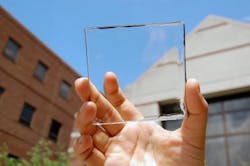Luminescent solar concentrator is transparent, colorless, doesn't block the view
A team of researchers at Michigan State University (East Lansing, MI) has developed a luminescent solar concentrator that is completely transparent in the visible region, allowing windows to be used to collect solar energy with no change in appearance.1
Cell phones and other devices are also potential targets for the technology.
A luminescent solar concentrator (LSC) is a pane of doped transparent material; incoming sunlight excites the dopant, which re-emits light that is mostly conducted via total internal reflection to the edge of the pane, where photovoltaic cells convert the light to electrical power.
The dopant in conventional LSCs is tinted, often bright yellow or red, making the concentrator unsuitable for use as a window. The dopants in the new LSC only absorb light in the UV and near-IR regions (emitting it as IR), which makes the device colorless in appearance.
This ain't no disco
"No one wants to sit behind colored glass," says Richard Lunt, one of the researchers. "It makes for a very colorful environment, like working in a disco."
The new LSC uses small organic molecules developed as dopants by Lunt and his team.
"It opens a lot of area to deploy solar energy in a nonintrusive way," Lunt says. "It can be used on tall buildings with lots of windows or any kind of mobile device that demands high aesthetic quality like a phone or e-reader. Ultimately we want to make solar harvesting surfaces that you do not even know are there."
Lunt says more work is needed in order to improve the efficiency of the LSC. Currently it has a solar-conversion efficiency close to 1%; the researchers aim to produce efficiencies beyond 5%. The best colored LSC to date has an efficiency of around 7%.
Source: http://msutoday.msu.edu/news/2014/solar-energy-that-doesnt-block-the-view/
REFERENCE:
1. Yimu Zhao et al., Advanced Optical Materials (2014); doi: 10.1002/adom.201400103

John Wallace | Senior Technical Editor (1998-2022)
John Wallace was with Laser Focus World for nearly 25 years, retiring in late June 2022. He obtained a bachelor's degree in mechanical engineering and physics at Rutgers University and a master's in optical engineering at the University of Rochester. Before becoming an editor, John worked as an engineer at RCA, Exxon, Eastman Kodak, and GCA Corporation.
